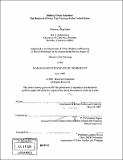Shifting urban priorities : the removal of inner city freeways in the United States
Author(s)
Napolitan, Francesca
DownloadFull printable version (10.60Mb)
Other Contributors
Massachusetts Institute of Technology. Dept. of Urban Studies and Planning.
Advisor
P. Christopher Zegras.
Terms of use
Metadata
Show full item recordAbstract
The United States Interstate Highway System transformed the nation's cities and countryside, accelerating suburbanization and leading to unprecedented levels of motorized mobility. While the interstate highways brought undeniable benefits, they also imparted social, environmental and aesthetic costs. Growing opposition to the paving of cities in the name of improved mobility resulted in a "freeway revolt" movement. Much of the original interstate infrastructure built in the 1950s and 1960s is reaching or is past the end of its useful life - requiring large investments for rehabilitation. At the same time, the freeway revolt has evolved into a more widespread movement, underlined by values such as sustainability. Thus, the vigorous debate over the future of urban highways and mobility continues. This thesis examines this future from the perspective of a fairly recent phenomenon: urban freeway removal. By examining three different cases where urban freeway removal was a seriously considered option - two where the freeway was removed and replaced with a lower capacity at-grade boulevard (Park East Freeway, Milwaukee and Central Freeway, San Francisco) and one where the freeway ultimately was not removed (Whitehurst Freeway, Washington D.C.) this thesis works toward a theory of highway removal. (cont.) The analysis suggests that freeway removal will only take place when: (1) the one precondition is met: the condition of the freeway must be such, that there is concern over its integrity and structural safety, (2) a window of opportunity exists; the window may the precondition itself or another event that enables a freeway removal alternative to gain serious consideration and legitimacy, (3) the value of mobility must be lower than other objectives such as economic development, quality of life, etc., and (4) those in power must value other benefits more than they value the benefits associated with freeway infrastructure for the alternative of freeway removal to be selected over other alternatives.
Description
Thesis (M.C.P.)--Massachusetts Institute of Technology, Dept. of Urban Studies and Planning, 2007. Includes bibliographical references (p. 132-136).
Date issued
2007Department
Massachusetts Institute of Technology. Department of Urban Studies and PlanningPublisher
Massachusetts Institute of Technology
Keywords
Urban Studies and Planning.